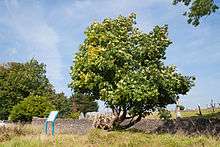Fintan of Clonenagh
Saint Fintan of Clonenagh (CA. 526 - 603) was an Irish hermit and monk. He was an Abbot and disciple of Columba of Terryglass.
Saint Fintan of Clonenagh | |
|---|---|
| Born | c. 526[1] |
| Canonized | pre-congregation |
Life
Fintan was born in about 526, the son of Christians Gabhren and Findlath.[2]
The monastery at Clonenagh was founded in the 6th century by Fintan of Clonenagh who entrusted it to his disciple Columba when Colum moved on to Terryglass around 548. Fintan received his religious formation under the Abbot Colum, and was deeply influenced by his penitential practices and the severity of his Rule. Under his direction Fintan developed a reputation for austerity.[3]
Fintan gave his monks very strict rules not to consume any animal products.[4] The community did not have even one cow and so they had neither milk nor butter. The monks complained they couldn’t do hard work on so meagre a diet. A deputation of local clergy headed by Canice of Aghaboe came to urge him to improve it. He agreed for his monks, but he elected to keep to the strict diet himself.[3] Fintan was reported to have lived on only "bread of woody barley and clayey water of clay".[5]
His disciples included St Colmán of Oughaval, and St. Comgall of Bangor.[6] He has been compared by the Irish annalists to St. Benedict, and is styled "Father of the Irish Monks".[7]
Fintan of Clonenagh is regarded as one of three patron saints of county Laois which include Colman Mac ua Laoise and Mochua of Timahoe.[8] He died in 603. His feast day is on February 17.
Though he is sometimes confused with Saint Fintán or Munnu, abbot of Taghmon, they are distinct.
St. Fintan's Tree, Clonenagh

This tree, an acer pseudoplatanus, was planted in the late 18th or early 19th century at the site of the Early Christian monastic site of Clonenagh. The tree is dedicated to St. Fintan and it became custom to insert coins into the tree from which the tree suffered and was believed to be dead until the tree started to recover with some new shoots." (Heritage Tree Database, Tree Council of Ireland)
References
- Berry, Albert. “Saint Fionntan”. Lives of Irish Saints. CatholicSaints.Info. 27 February 2014
- John Lanigan (1829). An Ecclesiastical History of Ireland, From the First Introduction of Christianity to the Beginning of the Thirteenth Century. Printed for J. Cumming. p. 227.
- "St. Fintan of Clonenagh", Catholic Ireland
- Baring-Gould, Sabine. (1914). The Lives of the Saints, Volume 2. Edinburgh: John Grant. p. 324. "The rules he gave his monks were very strict; they abstained from all kind of meat, butter and milk; living only upon vegetables."
- Jones, Kathleen. (2002). Who are the Celtic Saints?. Canterbury Press. p. 38. ISBN 978-1853114939
- "History of Bangor Abbey", Parish of Bangor Abbey Archived 6 March 2015 at the Wayback Machine
-

- Murray, Sean. "St. Fintan of Clonenagh", Laois Archaeology
Further reading
- Millar, Seamus. "St Fintan of Clonenagh." Carloviana: Journal of the Old Carlow Society 1:22 (1973): 10-12. RHS record.
- Sperber, Ingrid. "'Late and not of special distinction'? The misunderstood Life of St Fintan of Clonenagh". In Ossory, Laois and Leinster 1 (2004): pp. 28–49. ISSN 1649-4938. RHS record.